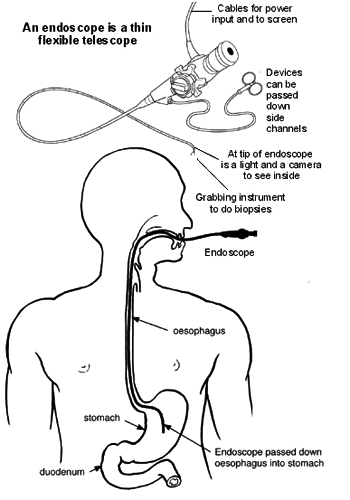
Gastroscopy


Diagnostic Gastroscopy
Gastroscopy is a test to look inside the oesophagus, stomach and duodenum.
What is a gastroscopy?

A gastroscopy is a test where a doctor looks into the upper part of your gut (the upper gastrointestinal tract).
The upper gut consists of the oesophagus (gullet), stomach and duodenum.
The operator uses an endoscope to look inside your gut. Therefore, the test is sometimes called endoscopy .The endoscope is passed through the mouth, into the oesophagus and down towards the stomach and duodenum.
Who has a gastroscopy?
A gastroscopy may be advised if you have symptoms such as recurring indigestion, recurring heartburn, pains in the upper abdomen, repeated vomiting, difficulty swallowing, or other symptoms thought to be coming from the upper gut.
The sort of conditions which can be confirmed (or ruled out) include:
• Oesophagitis (inflammation of the oesophagus). The operator will see areas of redness on the lining of the oesophagus.
• Duodenal and stomach ulcers. An ulcer looks like a small, red crater on the inside lining of the duodenum or stomach.
• Duodenitis and gastritis (inflammation of the duodenum and stomach).
• Cancer of the stomach and oesophagus.
What happens during a gastroscopy?
Gastroscopy is usually done as an outpatient 'day case'.
The operator may numb the back of your throat by spraying on some local anaesthetic, or give you an anaesthetic lozenge to suck. You may be given a sedative to help you to relax. This is usually given by an injection into a vein in the back of your hand.
You lie on your side on a couch. You are asked to put a plastic mouth guard between your teeth. This protects your teeth and stops you biting the endoscope. The operator will then ask you to swallow the first section of the endoscope. Modern endoscopes are quite thin and easy to swallow. The operator then gently pushes it further down your oesophagus, and into your stomach and duodenum. The video camera at the tip of the endoscope sends pictures to a screen. The operator watches the screen for abnormalities of the oesophagus, stomach and duodenum. Air is passed down a channel in the endoscope into the stomach to make the stomach lining easier to see. This may cause you to feel 'full' and want to belch.
The operator may take one or more biopsies (small samples) of parts of the inside lining of the gut - depending on why the test is done and what they see. This is painless. The endoscope is then gently pulled out.
A gastroscopy usually takes about 10 minutes.
A gastroscopy does not usually hurt, but it can be a little uncomfortable, particularly when you first swallow the endoscope.
What preparation do I need to do?
The sort of instructions given commonly includes:
• You should not eat for 4-6 hours before the test. The stomach needs to be empty. (Small sips of water may be allowed up to two hours before the test.)
• If you have a sedative you will need somebody to accompany you.
What can I expect after a gastroscopy?
Most people are ready to go home after resting for half an hour or so.
If you have had a sedative - you may take a bit longer to be ready to go home. The operator writes a report and sends it to the doctor who requested the gastroscopy.
Are there any side-effects or complications from having a gastroscopy?
Most gastroscopies are done without any problem. Some people have a mildly sore throat for a day or so afterwards. Some may have feeling of bloating for few hours.